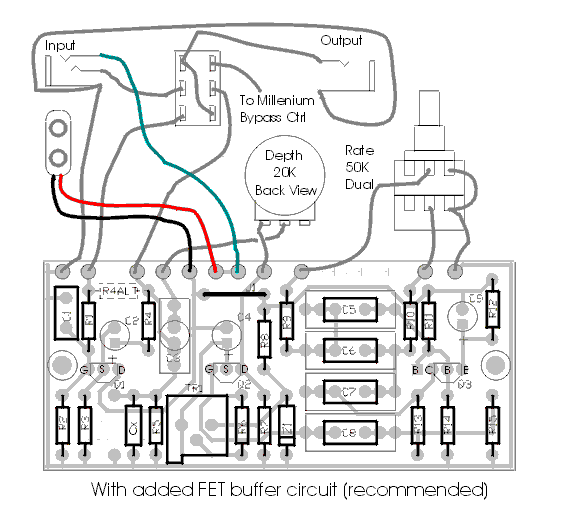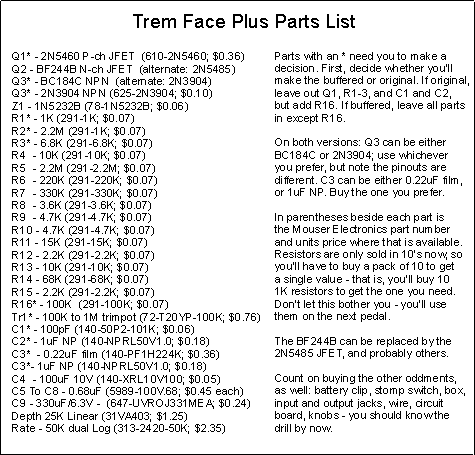| I did a PCB layout of the third schemo. The
layout lets you build either the buffered version from schematic 3, or
the unbuffered original version in schemo 2 by just leaving some parts
out and placing one resistor differently.
The layout above is the full version. You'll need to make some choices here. Notice that there is an unusually large area around capacitors C3 and 5 through 8. This is because those caps may wind up being physically large. C3 is a 0.24uF film type in the original circuit. I've included a space for that, but a 1uF NP electro cap would work as well, and might be more available. The circle shows where the NP electro would go, and the rectangle where the film type would go. The extra holes are to accommodate a variety of lead spacings. Caps 5 through 7 are even larger, 0.68uF. Fortunately, these caps do not carry audio in this circuit, so you could use ceramic. I've added space that will allow even film types. The parts list includes several part numbers that will work. As a result of my bench experience with Ed Crozier's Trem Faces, I strongly, strongly recommend that you make C8 a non-polar type. In spite of the fact that both original units I worked on and the one pictured on Dave's page had tantalum capacitors for C5-C8, I think that this is flirting with failure. Use film capacitors (about $0.50 each) or non polarized (about $0.30 each) or ceramic caps for these positions. They do not affect the audio signal, as no audio goes through them. There are four pads under Q3, the oscillator transistor. That is to allow you to some freedom in selecting a transistor. Small TO-92 packaged transistors come in a variety of pinouts, the most common ones being EBC and ECB (as viewed looking at the flat with the leads down). The original BC184C is an ECB part; however, many of the more common transistors in the USA are EBC. Pick the transistor you can get - a "vintage" or "NOS" BC184C will do not one thing to make this pedal sound original. If you have one, fine. If not, you can use any one of several devices, notably the ever-popular and common as dirt 2N3904. The 3904 is EBC. Here's how the layout accomodates the two types. I laid it out for EBC (that's what I can get easiest, and hey, I'm doing the layout, so why not 8-) but I added the fourth, square pad. The pad is connected to the center/base pad of the three plain pads. By shifting the transistor over one pad and bending the emitter lead to reach farther, the ECB layout fits in neatly too. Neat, huh? The JFET is laid out for the common DSG pinout of most JFETs. Here's a mystery - the datasheets I found for the BF244 say that it's DSG pinout, but the one on the board is wired DGS, and actually works that way. Maybe some BF244's have a different pinout. My "dirty tricks" hackles always come up when a part has a nonstandard pinout, but this seems to be real. I bet if you buy a BF244, it comes DSG. Check it with your ohmmeter to be sure.
|

